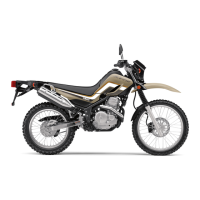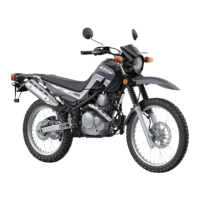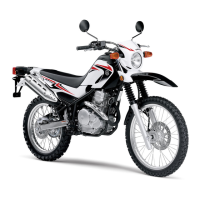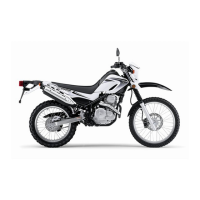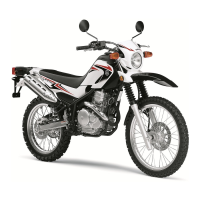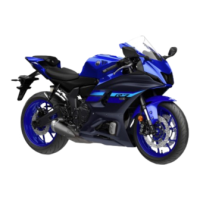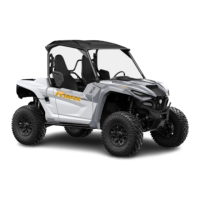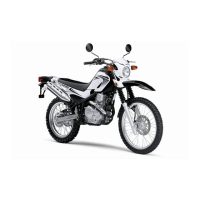Do you have a question about the Yamaha XT250 2024 and is the answer not in the manual?
Details of warning and tire information labels.
Owner's responsibility and safe riding practices.
Pre-operation checks, rider posture, and hazard awareness.
Importance of helmets, face shields, and protective clothing.
Hazards of exhaust fumes and safe practices.
Effects of cargo on stability and weight distribution.
Safety considerations for aftermarket parts and modifications.
Precautions for securing the motorcycle during transport.
Identification of components on the left side of the motorcycle.
Identification of components on the right side of the motorcycle.
Overview of handlebar controls and instrument panel layout.
Operation of the ignition and steering lock mechanism.
Explanation of dashboard indicator and warning lights.
Features and operation of the digital display.
Controls located on the left and right handlebars.
Operation and adjustment of clutch and gear shifting.
Operation of front and rear braking controls.
Procedures for removing and installing the fuel tank cap.
Fueling safety advice and recommended fuel types.
Instructions for removing and installing the seat.
Location and use of the helmet holder.
How to adjust rear shock absorber spring preload.
Operation and safety switch of the sidestand.
System preventing starting with sidestand down or in gear.
Pre-ride inspection of fuel level and lines.
Pre-ride inspection of engine oil level and for leaks.
Pre-ride inspection of front brake operation and fluid.
Pre-ride inspection of rear brake operation and fluid.
Pre-ride inspection of clutch and throttle operation.
Pre-ride inspection of drive chain and tire condition.
Pre-ride checks of sidestand, lights, and switches.
Recommended break-in procedures for engine longevity.
Steps for starting the engine safely.
How to shift gears and recommended shift points.
Safe procedures for parking the motorcycle.
Location and use of the provided tool kit.
Inspection and replacement of fuel hoses.
Checking, cleaning, and replacing the spark plug.
Checking and changing engine oil and filter.
Procedure for replacing the air filter element.
Importance and procedure for adjusting valve clearance.
Tire maintenance, condition, and air pressure.
Adjusting levers, checking pads, and fluid levels.
Checking, adjusting, cleaning, and lubricating the drive chain.
Inspection and lubrication of control cables.
Inspecting front fork and steering bearing condition.
Inspecting wheel bearings for play or smooth operation.
Battery location and maintenance.
Procedures for replacing headlight, tail/brake, turn signal bulbs and fuses.
Procedures for removing and installing front and rear wheels.
Guide for diagnosing and resolving common starting issues.
Proper procedures for washing, drying, and polishing the motorcycle.
Recommendations for storing the motorcycle, including long-term.
Physical specifications of the motorcycle.
Details on engine type, displacement, fuel, and tank capacity.
Tire sizes, types, and wheel specifications.
Types of brakes, suspension, and electrical system details.
Specifications for headlights and other lights.
Location of VIN, engine serial, and key ID numbers.
Details on model and emission control information labels.
A chart for recording service intervals and dates.
Procedure for reporting vehicle safety defects to authorities.
Duration of warranty coverage for pleasure and commercial use.
Process for transferring warranty and obtaining repairs.
Conditions and damages not covered by the warranty.
Specific warranty for emissions and storage recommendations.
Details of warning and tire information labels.
Owner's responsibility and safe riding practices.
Pre-operation checks, rider posture, and hazard awareness.
Importance of helmets, face shields, and protective clothing.
Hazards of exhaust fumes and safe practices.
Effects of cargo on stability and weight distribution.
Safety considerations for aftermarket parts and modifications.
Precautions for securing the motorcycle during transport.
Identification of components on the left side of the motorcycle.
Identification of components on the right side of the motorcycle.
Overview of handlebar controls and instrument panel layout.
Operation of the ignition and steering lock mechanism.
Explanation of dashboard indicator and warning lights.
Features and operation of the digital display.
Controls located on the left and right handlebars.
Operation and adjustment of clutch and gear shifting.
Operation of front and rear braking controls.
Procedures for removing and installing the fuel tank cap.
Fueling safety advice and recommended fuel types.
Instructions for removing and installing the seat.
Location and use of the helmet holder.
How to adjust rear shock absorber spring preload.
Operation and safety switch of the sidestand.
System preventing starting with sidestand down or in gear.
Pre-ride inspection of fuel level and lines.
Pre-ride inspection of engine oil level and for leaks.
Pre-ride inspection of front brake operation and fluid.
Pre-ride inspection of rear brake operation and fluid.
Pre-ride inspection of clutch and throttle operation.
Pre-ride inspection of drive chain and tire condition.
Pre-ride checks of sidestand, lights, and switches.
Recommended break-in procedures for engine longevity.
Steps for starting the engine safely.
How to shift gears and recommended shift points.
Safe procedures for parking the motorcycle.
Location and use of the provided tool kit.
Inspection and replacement of fuel hoses.
Checking, cleaning, and replacing the spark plug.
Checking and changing engine oil and filter.
Procedure for replacing the air filter element.
Importance and procedure for adjusting valve clearance.
Tire maintenance, condition, and air pressure.
Adjusting levers, checking pads, and fluid levels.
Checking, adjusting, cleaning, and lubricating the drive chain.
Inspection and lubrication of control cables.
Inspecting front fork and steering bearing condition.
Inspecting wheel bearings for play or smooth operation.
Battery location and maintenance.
Procedures for replacing headlight, tail/brake, turn signal bulbs and fuses.
Procedures for removing and installing front and rear wheels.
Guide for diagnosing and resolving common starting issues.
Proper procedures for washing, drying, and polishing the motorcycle.
Recommendations for storing the motorcycle, including long-term.
Physical specifications of the motorcycle.
Details on engine type, displacement, fuel, and tank capacity.
Tire sizes, types, and wheel specifications.
Types of brakes, suspension, and electrical system details.
Specifications for headlights and other lights.
Location of VIN, engine serial, and key ID numbers.
Details on model and emission control information labels.
A chart for recording service intervals and dates.
Procedure for reporting vehicle safety defects to authorities.
Duration of warranty coverage for pleasure and commercial use.
Process for transferring warranty and obtaining repairs.
Conditions and damages not covered by the warranty.
Specific warranty for emissions and storage recommendations.
| Engine Type | 249cc air-cooled SOHC 4-stroke; 2 valves |
|---|---|
| Bore x Stroke | 74.0mm x 58.0mm |
| Compression Ratio | 9.5:1 |
| Ignition | TCI: Transistor Controlled Ignition |
| Transmission | 5-speed; multiplate wet clutch |
| Final Drive | Chain |
| Rear Suspension | Single shock; 7.1-in travel |
| Front Brake | Single disc, 245mm |
| Rear Brake | Single disc, 203mm |
| Front Tire | 2.75-21 |
| Rear Tire | 120/80-18 |
| Wheelbase | 53.5 in |
| Seat Height | 31.9 in |
| Fuel Capacity | 2.6 gal |
| Wet Weight | 291 lb |
| Height | 45.7 in |
| Ground Clearance | 11.2 in |
| Fuel Delivery | Fuel Injection |
| Front Suspension | Telescopic fork; 8.9-in travel |
